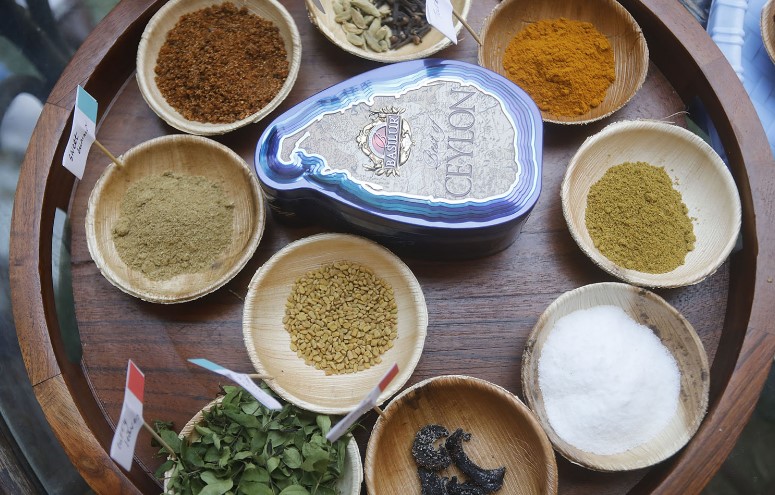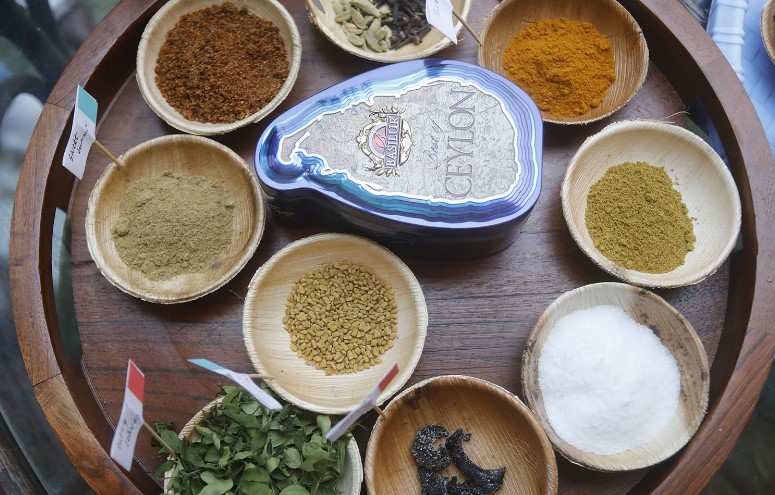By Anweiti Upadhyay/The Kathmandu Post
Kathmandu, April 21: On a pleasant spring morning, The SAARC House was abuzz with activity. A tent was propped up in the courtyard. More than a dozen women and men were seated underneath it. Colourful leaflets with detailed recipes for Sri Lankan dishes were placed on each table. At the right side of the tent, different spices commonly used in Sri Lankan cooking were displayed in coconut shell bowls placed atop nanglos. Some spices were placed inside a teardrop-shaped box, made in the shape of the island nation with the Sri Lankan map printed on its lid.
The occasion was a cookout session hosted by Krishanti Weerakoon, who is the daughter and wife of a diplomat. She’s had a multidimensional life–a humanitarian worker in the United Nations, an etiquette expert and a former Director of Foreign Affairs in the Presidential Secretariat, Sri Lanka. She is currently in Nepal with her husband, Esala Weerakoon, the Secretary General of SAARC.
Most of the guests present at The SAARC House were members of Tasneem’s Cookout sessions organised by Tasneem’s King’s Kitchen. In these sessions, the restaurant’s founder Tasneem Shahani arranges for the members of the cookout to learn recipes from a different cuisine every month. Weerakon, who is very passionate about cooking, has been attending Shahani’s cooking classes for some time. “Krishanti was very interested in showcasing Sri Lankan cuisine through the cookout session. Since there aren’t any Sri Lankan restaurants in Kathmandu, we thought this would be a great way to introduce the cuisine to our members,” says Shahani.
As the attendees were buzzing about with excitement, murmuring amongst each other while reading through the leaflet, Weerakon entered in a turquoise saree with a big smile on her face. She greeted everyone in the vicinity, addressing each person by their name, and everybody greeted her back. The session began with the host explaining how each of the displayed spices is used in Sri Lankan cooking. She spoke of the rich diversity of food and styles seen in the country’s cuisine.
In spite of its small size, Sri Lanka boasts an amazing diversity of food and styles of cooking. Sri Lankan cooking takes advantage of the wide variety of native fruit and vegetables, as well as the many spices that grow on the island. Coconut and coconut milk are also among the major ingredients used. Rice is the staple. Fresh and dried seafood is, of course, plentiful. The island has a rich heritage of native dishes, and its regional cooking is varied. For example, cuisine in the Central Province has its emphasis on hill country vegetables and fruits; coastal area cooking utilises seafood, and South Indian cuisine has widely influenced culinary practices in the Northern and Eastern provinces.
In addition to the regional characteristics, some of the popular dishes reflect influences from other lands. Sri Lanka has a colonial legacy of almost 450 years, with foreigners who came and stayed, either as traders or conquerors—including the Indians, Arabs, Malays, Moors, Portuguese, Dutch and British. They have influenced the nation’s cuisine.
Then, Weerakoon, assisted by Manju Thapa Magar and Binita KC, the head and assistant chefs at The SAARC House, demonstrated how a variety of dishes from Sri Lanka—namely, chicken curry, bean curry, Brinjal Moju, and cashew curry—are made. This was followed by chef Anoma Shrestha, who runs a catering service in Kathmandu and is Sri Lankan by birth, demonstrating how to make hoppers, Sri Lankan style.
The session ended with a big feast, made in The SAARC House, that featured every dish demonstrated earlier alongside other delicacies, including Wattalapam, Pol Sambol, Lunu Miris and Kiri Bath, among others.
I found Sri Lankan cuisine quite similar to Nepali. Coconut milk gives it a unique flavourful sweetness that isn’t present in most Nepali dishes—the savoury ones, at least. Some of the dishes served were also quite spicy—all too fitting for the Nepali palette.
END
The post The flavours of Sri Lanka appeared first on NewsIn.Asia.




